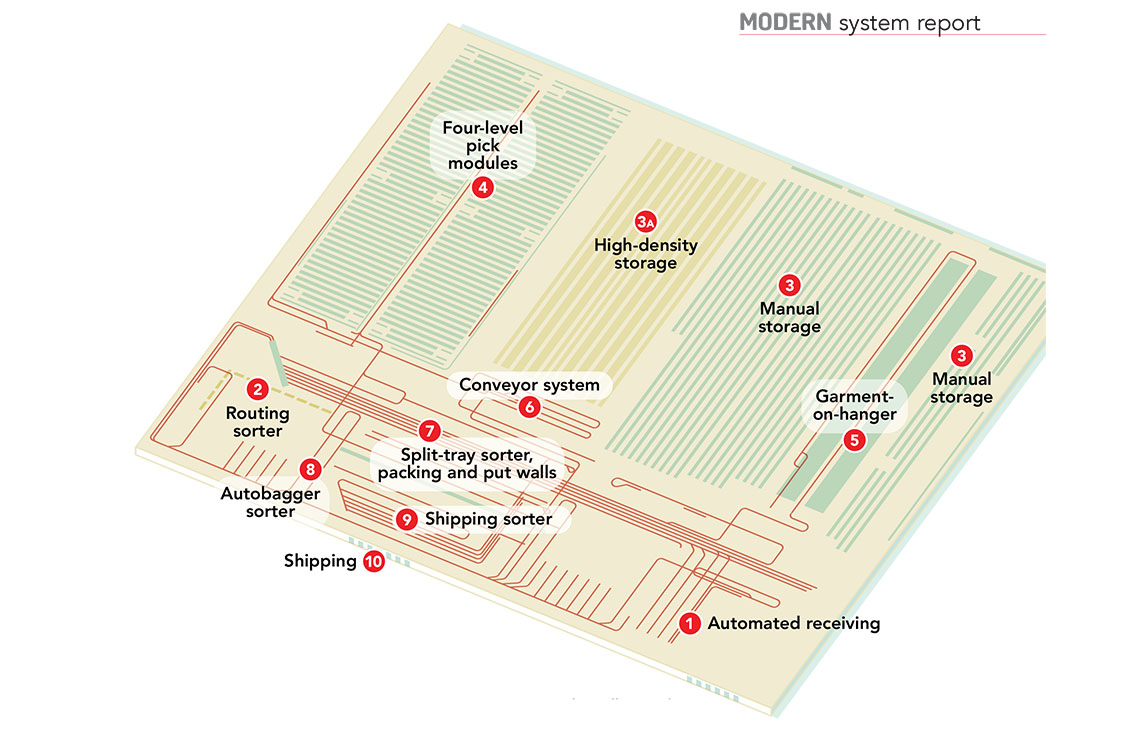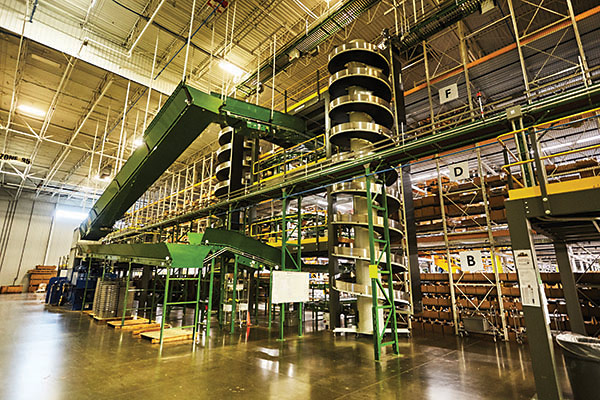In its e-fulfillment center, Gap Inc. brought together conveyor, sortation, mini-load and shuttle storage systems, robots and automatic truck loading to significantly reduce the number of times product is handled from receiving to shipping.
Gap Inc.
Gallatin, Tenn.
Square Footage: 500,000 square feet. One of 3 buildings totaling 2.5 million square feet
Brand Serviced: Multi-brand e-commerce fulfillment for Athleta and Banana Republic, and Old Navy during the holiday season
Products Handled: Apparel, footwear and accessories
SKUs: 100,000 SKUs and up to 170,000 SKUs during holiday seasons
Throughput: 250,000 to 300,000 a day up to 450,000 to 500,000 units per day
People/Shifts: 2 shifts per day/7 days per week
Read the MMH full feature article about the Gap Inc.‘s Gallatin facility
Receiving
Receiving begins when containers are unloaded at the port onto 53-foot trucks and advance ship notifications are sent to the distribution center that will receive them. When a trailer arrives at automated receiving (1) at the facility, the load information is downloaded into the system and cartons are unloaded onto the facility’s conveyor system, where they pass under an overhead scanner and dimensioner to receive that carton.
Storage
After the scan, cartons are sorted on a routing sorter (2) to a storage area. Cartons with the right dimensions are conveyed to the mini-load system for high-density storage (3A). The remainder are conveyed to a manual palletizing area (3) and then scanned into a pallet rack location or sent to an area for garments on hanger (5). Typically, about 70% of inventory is stored in the mini-load. Within a few hours of arrival, inventory is available to promise.

Picking
Retail and e-commerce orders are picked simultaneously in a waveless pick environment. Orders drop to the facility from the warehouse management system (WMS) and then are grouped into single-line and multi-line orders by the warehouse execution system. In the four-level pick modules (4), associates pick items to totes until the work is complete and the tote is inducted onto the conveyor (6) and routed to packing (7). Items may also be picked from the garment-on-hanger area.
Singles-line packing
Items that can be handled by the auto-bagger in the singles line packing area are removed from a tote, scanned and inducted onto the conveyor. Once they are automatically bagged (8), they are conveyed to the shipping sorter (9) and sent to the appropriate shipping lane (10).
Multi-line packing
Multi-line orders, and single line orders that aren’t eligible for the auto-bagger, are conveyed to a multi-line processing area. There, items are scanned onto a split-tray sortation system (6), which sorts them to chute leading to a put wall in the packing area. The items are scanned into a cubby location on one side of the cubby. When the order is complete, a packer on the other side is notified that it is ready for packing. Packed orders are inducted onto the conveyor and routed to packing.
Robotic packing
With single line orders already automated, Gap Inc. has installed a handful of robotic put walls in the packing area at the Gallatin and Fresno facilities, a first step toward automating some of the multi-line packing process. From the split-tray sorter, items drop down a chute into the robotic put wall. There a robotic arm picks up an item. Based on a scan of the item, the robot is directed to place it in a specific cubby. When the order is complete, a packer on the other side is notified, and packing is completed like other multi-line orders.
Shipping
From the shipping sorter, packages are automatically loaded onto trucks for shipping.
System suppliers:
- Systems Integration & Warehouse Execution System: Vargo
- Piece Picking Robotic Put Wall: Kindred
- Conventional Put Wall: Speedrack
- Sortation: Dematic and Hytrol
- Automated Storage and conveyor: TGW
- Controls: LaFayette Engineering, Inc.
- Automated Packaging: Accutech
- WMS: Manhattan and Vargo
- Racking: Interlake Mecalux
- Split-Tray Sorter: EuroSort
- Bar Code Scanning: SICK (fixed, overhead), Zebra
- Technologies
(handheld) - Lift Truck: Raymond
- Automatic Truck Loading: FMH Conveyors (BestReach)
Article topics








